Implementing Material Design in Your Android app
October 24th, 2014 | Published in Google Android
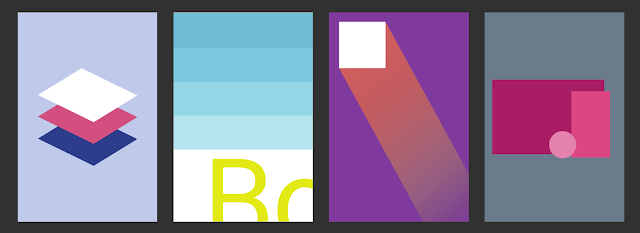
Material design is a comprehensive approach to visual, interaction and motion design for the multi-screen world. Android 5.0 Lollipop and the updated support libraries help you to create material UIs. Here’s a rundown of some of the major elements of material design and the APIs and widgets that you can use to implement them in your app.
Tangible surfaces
In material design, UIs are composed of pieces of digital paper & ink. The surfaces and the shadows they cast provide visual cues to the structure of the application, what you can touch and how it will move. This digital material can move, expand and reform to create flexible UIs.
Shadows
A surface’s position and depth result in subtle changes in lighting and shadows. The new elevation property lets you specify a view’s position on the Z-axis and the framework then casts a real-time dynamic shadow on items behind it. You can set the elevation declaratively in your layouts, defined in dips:
You can also set this from code using getElevation()/setElevation() (with shims in ViewCompat). The shadow a view casts is defined by its outline, which by default is derived from its background. For example if you set a circular shape drawable as the background for a floating action button, then it would cast an appropriate shadow. If you need finer control of a view’s shadow, you can set a ViewOutlineProvider which can customise the Outline in getOutline().
Cards
Cards are a common pattern for creating surfaces holding a distinct piece of information. The new CardView support library allows you to create them easily, providing outlines and shadows for you (with equivalent behaviour on prior platforms).
CardView extends FrameLayout and provides default elevation and corner radius for you so that cards have a consistent appearance across the platform. You can customise these via the cardElevation and cardCornerRadius attributes, if required. Note that Cards are not the only way of achieving dimensionality and you should be wary of over-cardifying your UI!
Print-like Design
Material utilises classic principles from print design to create clean, simple layouts that put your content front and center. Bold deliberate color choices, intentional whitespace, tasteful typography and a strong baseline grid create hierarchy, meaning and focus.
Typography
Android 5.0 updates the system font Roboto to beautifully and clearly display text no matter the display size. A new medium weight has been added (android:fontFamily=”sans-serif-medium”) and new TextAppearance styles implement the recommended typographic scale for balancing content density and reading comfort. For instance you can easily use the ‘Title’ style by setting android:textAppearance=”@android:style/TextAppearance.Material.Title”. These styles are available on older platforms through the AppCompat support library, e.g. “@style/TextAppearance.AppCompat.Title”.
Color
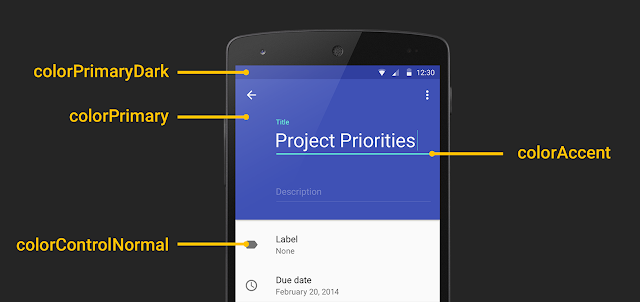
Your application’s color palette brings branding and personality to your app so we’ve made it simple to colorize UI controls by using the following theme attributes:
-
colorPrimary. The primary branding color for the app; used as the action bar background, recents task title and in edge effects. -
colorAccent. Vibrant complement to the primary branding color. Applied to framework controls such as EditText and Switch. -
colorPrimaryDark. Darker variant of the primary branding color; applied to the status bar.
Further attributes give fine grained control over colorizing controls, see: colorControlNormal, colorControlActivated, colorControlHighlight, colorButtonNormal, colorSwitchThumbNormal, colorEdgeEffect, statusBarColor and navigationBarColor.
AppCompat provides a large subset of the functionality above, allowing you to colorize controls on pre-Lollipop platforms.
Dynamic color
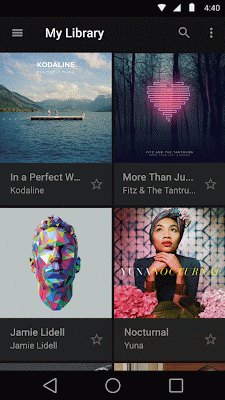
Material Design encourages dynamic use of color, especially when you have rich images to work with. The new Palette support library lets you extract a small set of colors from an image to style your UI controls to match; creating an immersive experience. The extracted palette will include vibrant and muted tones as well as foreground text colors for optimal legibility. For example:
Palette.generateAsync(bitmap,
new Palette.PaletteAsyncListener() {
@Override
public void onGenerated(Palette palette) {
Palette.Swatch vibrant =
palette.getVibrantSwatch();
if (swatch != null) {
// If we have a vibrant color
// update the title TextView
titleView.setBackgroundColor(
vibrant.getRgb());
titleView.setTextColor(
vibrant.getTitleTextColor());
}
}
});
Authentic Motion
Tangible surfaces don’t just appear out of nowhere like a jump-cut in a movie; they move into place helping to focus attention, establish spatial relationships and maintain continuity. Materials respond to touch to confirm your interaction and all changes radiate outward from your touch point. All motion is meaningful and intimate, aiding the user’s comprehension.
Activity + Fragment Transitions
By declaring ‘shared elements’ that are common across two screens you can create a smooth transition between the two states.
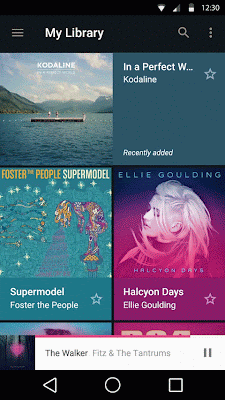.gif)
album_grid.xml
…
Here we define the same transitionName in two screens. When starting the new Activity and this transition is animated automatically. In addition to shared elements, you can now also choreograph entering and exiting elements.
Ripples
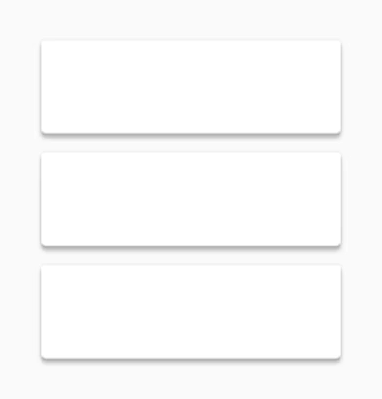
Materials respond to users’ touch with an ink ripple surface reaction. Interactive controls such as Buttons exhibit this behaviour by default when you use or inherit from Theme.Material (as will ?android:selectableItemBackground). You can add this feedback to your own drawables by simply wrapping them in a ripple element:
Custom views should propagate touch location down to their drawables in the View#drawableHotspotChanged callback so that the ripple can start from the touch point.
StateListAnimator
Materials also respond to touch by raising up to meet your finger, like a magnetic attraction. You can achieve this effect by animating the translationZ attribute which is analogous to elevation but intended for transient use; such that Z = elevation + translationZ. The new stateListAnimator attribute allows you to easily animate the translationZ on touch (Buttons do this by default):
layout/your_layout.xmlanim/raise.xml
Reveal
A hallmark material transition for showing new content is to reveal it with an expanding circular mask. This helps to reinforce the user’s touchpoint as the start of all transitions, with its effects radiating outward radially. You can implement this using the following Animator:
Animator reveal = ViewAnimationUtils.createCircularReveal(
viewToReveal, // The new View to reveal
centerX, // x co-ordinate to start the mask from
centerY, // y co-ordinate to start the mask from
startRadius, // radius of the starting mask
endRadius); // radius of the final mask
reveal.start();
Interpolators
Motion should be deliberate, swift and precise. Unlike typical ease-in-ease-out transitions, in Material Design, objects tend to start quickly and ease into their final position. Over the course of the animation, the object spends more time near its final destination. As a result, the user isn’t left waiting for the animation to finish, and the negative effects of motion are minimized. A new fast-in-slow-out interpolator has been added to achieve this motion.
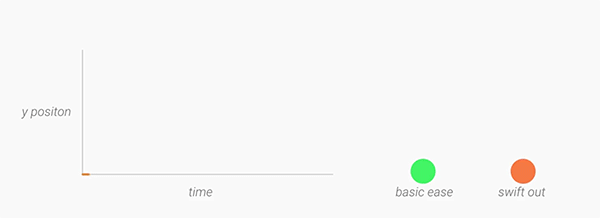
For elements entering and exiting the screen (which should do so at peak velocity), check out the linear-out-slow-in and fast-out-linear-in interpolators respectively.
Adaptive design
Our final core concept of material is creating a single adaptive design that works across devices of all sizes and shapes, from watches to giant TVs. Adaptive design techniques help us realize the vision that each device reflects a different view of the same underlying system. Each view is tailored to the size and interaction appropriate for that device. Colors, iconography, hierarchy, and spatial relationships remain constant. The material design system provides flexible components and patterns to help you build a design that scales.
Toolbar
The toolbar is a generalization of the action bar pattern, providing similar functionality, but much more flexibility. Unlike the standard action bar, toolbar is a view in your hierarchy just like any other, so you can place instances wherever you like, interleave them with the rest of your views, animate, react to scroll events and so on. You can make the Toolbar act as your Activity’s Action Bar by calling Activity.setActionBar().
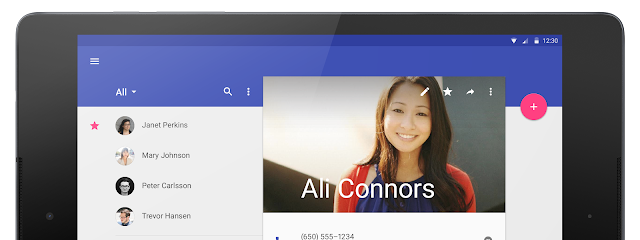
In this example, the blue toolbar is an extended height, overlaid by the screen content and provides the navigation button. Note that two further toolbars are used in the list and detail views.
For details of implementing toolbars, see this post.
Go Forth and Materialize
Material Design helps you to build understandable, beautiful and adaptive apps, which are alive with motion. Hopefully, this post has inspired you to apply these principles to your app and signposted some of the new (and compatibility) APIs to achieve this.
+Android Developers